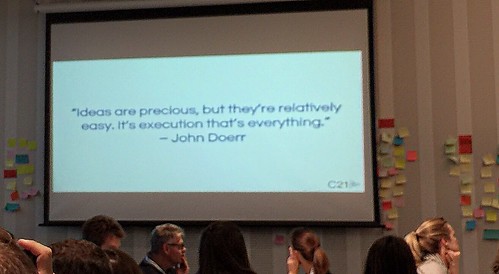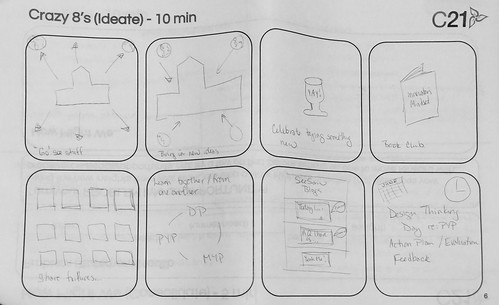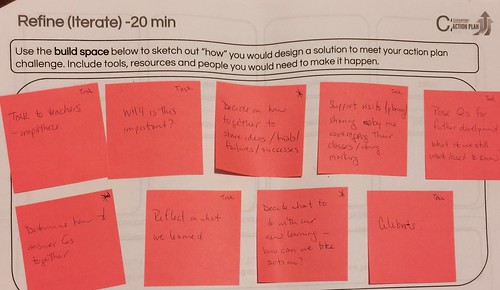Finally Experiencing Design Thining
Cross-posted from Cohort21 – January 15, 2017
—
I like the way Design Thinking is explained in this video:
However, I’m not sure that I agree everything in the video:
- I think that Design Thinking does have a map… there are steps to guide you on your way (though how you achieve each step can certainly vary)
- In Design Thinking the destination is not completely unknown… determining your design question describes where you want to go even though you may not be exactly sure where that is or how to get there!
However, in what could perhaps be the story of my life(!), my favourite line from the video is:
Design Thinking is a powerful tool to tackle the unknown. It’s a means of going on an expedition… with the confidence that you will end up somewhere great.
From Theory to Practice
I have long been interested in Design Thinking and found the resources in the IDEO Field Guide to Human-Centred Design to be very compelling. However, I had never been guided through the process and had only a hunch about its power…
My experience at the second Face to Face meeting for Cohort21 was a great way to experience the power of a Design Thinking process first hand. Working with so many passionate educators was at once compelling, exhausting and rewarding!
Defining My Design Challenge
In 2013, all K-7 teachers provided input and wrote our first ICT Philosophy document. In 2015 we invested in a review conducted by edtechteacher and as a result of the findings we wanted to elevate our use of technology to a tool for thinking rather than it’s predominant use as a tool for organization or to practice math and spelling skills.
Last year we revised our ICT Philosophy document. As part of this process we clarified what we wanted to teach, updated some of the language and crafted the following statement:
How we intend to achieve the UCC Mission through technology
At Upper Canada College, we use technology to nurture creativity, spark imagination and learn from failures. We strive to develop highly effective, self-directed, and ethical learners who make a difference to their life or the lives of others. Devices such as laptops and iPads are used as tools to take an active role in constructing understanding, demonstrating learning and interacting with the world. Teachers and students seamlessly integrate technology as objects to think with, to deepen understanding and innovate in ways not previously possible.
Despite the fact that our original document was several years old and teachers had invested time to write and revise it, it felt like the sentiments reflected in the Technology Vision statement could be more top of mind amongst teachers. I don’t mean to complain, teachers do A LOT of terrific work!
Creating a Design Question
In my first attempts at solving my problem, I came up with the following possible design questions:
- How might we develop an understanding of how technology can be used for inquiry and to deepen understanding?
- How might we be more transparent about how/ why / what we do with one another and parents?
- How might we be more willing to take risks and fail while learning from and with one another?
- How might we create a culture of innovation?
- How might we be more “PYP”?
As I was trying to come up with my design question, I realized that:
- In IB Primary Years Programme we are meant to teach kids to be risk-takers and thinkers who reflect and take action. How can we teach that if we don’t actually it ourselves?
- Technology is ubiquitous in our lives and the lives of our students. How can we leverage tech tools to help us deepen inquiry and understanding?
- In my role as a Technology Integrator I try my best to ensure that my classes focus on deepening understanding of concepts being addressed in other classes through the use of technology. I am unsure how much this approach continues when I am not in the classroom
- Teachers are not all comfortable taking risks which means their students may not take risks. What can be done to help teachers feel more comfortable with their ow failures?
Connecting, Extending and Challenging My Work
- I already knew:
- There are a lot of other people dealing with similar issues – in other departments and in other schools
- There is never enough time – there are always other interests competing for attention
- Change is constant and stressful for many
- A lack of vision is challenging – can we just do nothing while waiting for a new Strategic Plan to be developed?
- Risk-taking/ innovation is not really celebrated
- New ideas that pushed my thinking:
- I need to focus on PYP goals as first principles in the absence of whole-school guidance (via a new strategic plan)
- Challenges:
- Any plans I make could be derailed by the new strategic plan
- I don’t know how much teachers care about being innovative or integrating technology
- Creative solutions need to be found for finding the time to help teachers integrate technology effectively in order to help students
Empathizing
I gave some thought to how teachers might feel about technology integration and realized that, no matter what my design question ends up being, the average Primary teacher needs to feel like a valued professional because they have a wealth of insights and experience from working with students for many years.
Consolidating Thinking
At the start of the day, I thought that I needed to know where I was heading but by the end I came to the conclusion that we should follow an inquiry-based process ourselves and practice reflective learning.
Initially, my thoughts were all focused on the use of technology as a tool for learning. And although this remains my ultimate goal, throughout the day I realized that a safe environment for change needs to exist before change can actually take place.
Brainstorming Possible Solutions
I came up with a few possible solutions on my own:
Getting More Ideas from Others
I had some wonderful conversations with others who were addressing similar design challenges. This wasn’t my work but I wanted to remember many of the ideas suggested to Adam Ross and xxxxx.
It is very tempting to phrase my design challenge as “How might we utilize technology in a way that deepens student understanding?” But I think before asking teachers to do different things with technology, I would like to see a more cultural shift… so my current design question is:
How might we leverage a design thinking process to build a culture of innovation amongst Primary faculty?
My Next Steps (Which are Really Just Iterations of the Above Again):
- Empathize With My Users
- I have not yet officially interviewed a real user but have finally scheduled a time on January 16 to get at least one interview done!
- However, all has not been lost. I am co-chair of an IT Advisory Group at my school and as part of our work, I was able to ask them “How might we make the ICT philosophy come to life when everyone complains about meetings?” The group members offered the following suggestions that, ultimately, can become part of my Action Plan.
- Electronic communication
- Create a special section on the Technology Powerschool page
- Send email reminders
- Post on TV screens around the school
- Share video announcements for students and teachers
- Utilize social media
- Hold virtual meetings (could also include our high school or other schools as well)
- Paper-based
- Post signage around the school
- Just leave the document laying around e.g. in the Faculty Room
- Face to Face exchanges
- Re-schedule some Curriculum Co-ordinator meetings or Department meetings to become Technology Integration meetings instead
- Hold a smaller version of our annual Technology “Conference” on a PD Day
- Make it a requirement to provide info to others after attending a conference
- Host optional roundtable discussions
- Create a time to talk about technology at faculty meetings
- Encourage visits to one another’s classrooms
- Re-instate “Professional Conversations” that could be held a couple times a year and documented
- Share at school Assemblies
- The favourite: allow for a morning or afternoon to be spent with an integrator
- Electronic communication
- I need to spend more time talking to individual teachers about what they already know about the contents of our ICT Philosophy, find out what is easy for them, discuss what they struggle with and find out how they would like to be supported
- Find Patterns In the Data Users Provide
- What are the themes (topic) and insights (details) I can glean from whatever they share?
- Determine Design Principles
- Turn these insights into goals.
- Ideate and Make Ideas Tangible
- Go back and ask teachers “How might we achieve these goals?
- Together, determine how best to share ideas, what new things to try, how to learn from failures and how best to share successes
- Support teachers so that they can spend time observing or collaborating with others by covering their classes, ‘releasing them during ICT classes or doing some marking for them
- Spend some time outside the classroom with those who want to delve deeper into implementing something new to create a space for thinking
- Publish regular newsletters or blog posts with ideas for teachers to consider
- Iterate Relentlessly Based on Feedback from Others
- Pause occasionally and find out what we still want/need to find out – determine how to best answer those questions together
- Reflect on what we are learning
- Implement My Plan
- Together, decide what to do with our new learning – how can we take action?
- Celebrate!
I’m not sure where we will end up but I trust that it will be somewhere great!
PS. Many of my fears have been lessened as a result of work that has been done on our new Strategic Plan. We are still in the very early phases but after gathering input from the entire school it seems that a focus on education and changing trends, innovation and managing change are all topics that interest many of us. Phew!




Leave a Reply